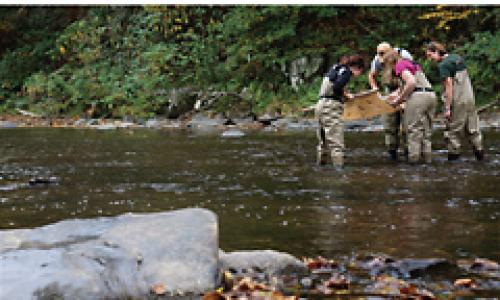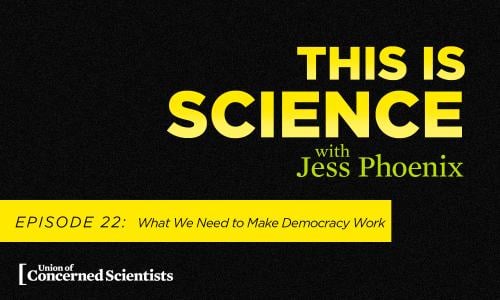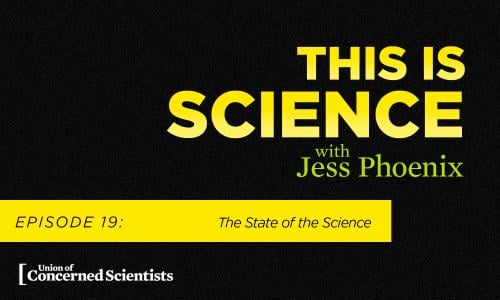NOTE: The following is one of a series of case studies produced by the Union of Concerned Scientists' Scientific Integrity Program between 2004 and 2010 to document the abuses highlighted in our 2004 report, Scientific Integrity in Policy Making.
The George W. Bush administration consistently sought to undermine the public’s understanding of the view held by the vast majority of climate scientists that human-caused emissions of carbon dioxide and other heat-trapping gases are making a discernible contribution to global warming.1
After coming to office, the administration asked the National Academy of Sciences (NAS) to review the findings of the Intergovernmental Panel on Climate Change (IPCC) and provide further assessment of what climate science could say about this issue.2 The NAS panel rendered a strong opinion, which, in essence, confirmed that of the IPCC. The American Geophysical Union, the world’s largest organization of earth scientists, has also released a strong statement describing human-caused disruptions of Earth’s climate.3 Yet even in the face of this overwhelming scientific concensus, Bush administration spokespersons continued to contend that the uncertainties in climate projections and fossil fuel emissions are too great to warrant mandatory action to slow emissions.4
In May 2002, President Bush expressed disdain for a State Department report5 to the United Nations that pointed to a clear human role in the accumulation of heat-trapping gases and detailed the likely negative consequences of climate change; the president called it “a report put out by the bureaucracy.”6 In September 2002, the administration removed a section on climate change from the Environmental Protection Agency’s (EPA) annual air pollution report,7 even though the climate issue had been discussed in the report in each of the preceding five years.
Then, in one well-documented case, the Bush administration blatantly tampered with the integrity of scientific analysis at a federal agency when, in June 2003, the White House tried to make a series of changes to the EPA’s draft Report on the Environment.8 A front-page article in the New York Times broke the news that White House officials tried to force the EPA to substantially alter the report’s section on climate change. The EPA report, which referenced the NAS review and other studies, stated that human activity is contributing significantly to climate change.9
Interviews with current and former EPA staff, as well as an internal EPA memo reviewed for this report, revealed that the White House Council on Environmental Quality and the Office of Management and Budget demanded major amendments including:
- The deletion of a temperature record covering 1,000 years in order to, according to the EPA memo, emphasize “a recent, limited analysis [that] supports the administration’s favored message.”10
- The removal of any reference to the NAS review—requested by the White House itself—that confirmed human activity is contributing to climate change.11
- The insertion of a reference to a discredited study of temperature records funded in part by the American Petroleum Institute.12
- The elimination of the summary statement—noncontroversial within the science community that studies climate change—that “climate change has global consequences for human health and the environment.”13
According to the internal EPA memo, White House officials demanded so many qualifying words such as “potentially” and “may” that the result would have been to insert “uncertainty...where there is essentially none.”14
In a political environment described by now-departed EPA Administrator Christine Todd Whitman as “brutal,”15 the entire section on climate change was ultimately deleted from the version released for public comment.16 According to internal EPA documents and interviews with EPA researchers, the agency staff chose this path rather than compromising their credibility by misrepresenting the scientific consensus.17 Doing otherwise, as one current, high-ranking EPA official puts it, would “poorly represent the science and ultimately undermine the credibility of the EPA and the White House.”18
The EPA’s decision to delete any mention of global warming from its report drew widespread criticism. Many scientists and public officials— Republicans and Democrats alike—were moved to decry the administration’s political manipulation in this case.
Notably, the incident drew the ire of Russell Train, who served as EPA administrator under Presidents Nixon and Ford. In a letter to the New York Times, Train stated that the Bush administration’s actions undermined the independence of the EPA and were virtually unprecedented for the degree of their political manipulation of the agency’s research. As Train put it, the “interest of the American people lies in having full disclosures of the facts.”19 Train also noted that, “In all my time at the EPA, I don’t recall any regulatory decision that was driven by political considerations. More to the present point, never once, to my best recollection, did either the Nixon or Ford White House ever try to tell me how to make a decision.”20
Were the case an isolated incident, it could perhaps be dismissed as an anomaly. On the contrary, the Bush administration repeatedly intervened to distort or suppress climate change research findings despite promises by the president that, “my Administration’s climate change policy will be science-based.”21
Despite the widespread agreement in the scientific community that human activity is contributing to global climate change, as demonstrated by the consensus of international experts on the IPCC, the Bush administration sought to exaggerate uncertainty by relying on disreputable and fringe science reports and preventing informed discussion on the issue. As one current EPA scientist puts it, the Bush administration often “does not even invite the EPA into the discussion” on climate change issues.
“This administration seems to want to make environmental policy at the White House,” the government scientist explained. “I suppose that is their right. But one has to ask: on the basis of what information is this policy being promulgated? What views are being represented? Who is involved in the decision making? What kind of credible expertise is being brought to bear?”22
Dr. Rosina Bierbaum, a Clinton administration appointee to the Office of Science and Technology Policy (OSTP) who also served during the first year of the Bush administration, offers a disturbing window on the process. From the start, Bierbaum contends, “The scientists [who] knew the most about climate change at OSTP were not allowed to participate in deliberations on the issue within the White House inner circle.” 23
Through such consistent tactics, the Bush administration not only distorted scientific and technical analysis on global climate change and suppressed the dissemination of research results, but avoided fashioning any policies that would significantly reduce the threat implied by those findings.
In the course of this investigation, UCS learned of the extent to which these policies seem to extend. In one case that has yet to surface in the press, the Natural Resources Conservation Service (NRCS) of the U.S. Department of Agriculture (USDA) sought in September 2003 to reprint a popular informational brochure about carbon sequestration in the soil and what farmers could do to reduce emissions of heat trapping gases. According to one current government official familiar with the incident, the brochure was widely viewed as one of the agency’s successful efforts in the climate change field. The NRCS had already distributed some 325,000 of the brochures and sought a modest update, as well as proposing a Spanish edition.24
Notably, even this relatively routine proposal was passed to the White House Council on Environmental Quality (CEQ) for review. William Hohenstein, director of the Global Change Program Exchange in the office of the chief economist at the USDA, acknowledged that he passed the request on to the CEQ, as he says he would “for any documents relating to climate change policy.”25 While Hohenstein denies that he was explicitly ordered to do so, he says he knows the White House was concerned “that things regarding climate change be put out by the government in a neutral way.”26
As a result of CEQ’s objections about the brochure, staff at the NRCS dropped their proposal for a reprint.27 “It is not just a case of micromanagement, but really of censorship of government information,” a current government official familiar with the case noted. “In nearly 15 years of government service, I can’t remember ever needing clearance from the White House for such a thing.”28
In March 2005 whistleblower Rick Piltz, a senior associate from the government office that coordinates federal climate change programs (now known as the Climate Change Science Program) resigned because he did not want "to sacrifice the ability to speak freely."29 Piltz declared that political appointees were working "to impede forthright communication of the state of climate science" and tried to "undermine the credibility and integrity of the program."30
The Government Accountability Project (GAP), a non-profit, public interest organization and law firm, is now representing Piltz. In June 2005, GAP gave the New York Times internal documents from Piltz’s office showing handwritten edits on several 2002 and 2003 scientific climate change reports. The edits increased and at times overstated the level of uncertainty associated with climate science. According to the New York Times, the edits tended "to produce an air of doubt about findings that most climate experts say are robust."31
The edits were made by Philip A. Cooney, then chief of staff of the White House Council on Environmental Quality, who formerly worked for the American Petroleum Institute and led the oil industry’s drive to prevent restrictions on greenhouse gas emissions.32 Mr. Cooney is a lawyer with no scientific training.
In one example, Cooney edited an October 2002 draft of a regularly published summary of government climate research, called "Our Changing Planet," by inserting the word "extremely" into the sentence: "The attribution of the causes of biological and ecological changes to climate change or variability is extremely difficult." In another instance, Cooney deleted a paragraph that projected reductions of mountain glaciers and snowpacks in a report examining the impact of global warming on water availability and flooding. In the margins he wrote that this was "straying from research strategy into speculative findings/musings."
The New York Times story appeared around the same time that British Prime Minister Tony Blair met with President Bush to urge the united States to take a stronger role in combating global warming. To bolster Blair’s argument, scientific academies in 11 countries including the United States released a joint letter stating, "The scientific understanding of climate change is now sufficiently clear to justify nations taking prompt action."
Despite the scientific academies' statement, at the June 8th daily White House press briefing spokesman Scott McClellan rebuffed accusations that the Bush administration actively sought to highlight the uncertainties involved in climate change science and downplay the link between the emission of heat-trapping gases and global climate change. The White House maintained that it is a normal procedure for political appointees to edit scientific documents.33
Two days after the original documents with Cooney’s edits were released, Cooney resigned.34 Just days later, Exxon Mobil Corporation announced that the company had hired Cooney for an unspecified position. The chairman of Exxon Mobil, Lee Raymond, has been an outspoken opponent of efforts to curb global warming. According to the Associated Press, Raymond has "come out strongly against the Kyoto Protocol and has repeatedly questioned the science behind climate change."35
Senate minority leader Harry Reid (D-NV) and Senator Frank Lautenberg (D-NJ) both called for an investigation by the Government Accountability Office into whether Cooney "violated laws on falsification of documents and obstruction of Congress" in revising the climate reports.36
1. This page is a modified excerpt from the 2004 UCS report Scientific Integrity in Policymaking.
2. National Academy of Sciences, Commission on Geosciences, Environment and Resources, Climate Change Science: An Analysis of Some Key Questions, 2001. Online at www.nap.edu/books/0309075742/html.
3. See www.agu.org/sci_soc/policy/climate_change_position.html.
4. P. Dobriansky, “Only New Technology Can Halt Climate Change,” Financial Times, December 1, 2003.
5. US Climate Action Report, Department of State, May 2002.
6. K.Q. Seelye, “President Distances Himself from Global Warming Report,” New York Times, June 5, 2002.
7. See www.epa.gov/airtrends.
8. “Report on the Environment,” U.S. Environmental Protection Agency, June 23, 2003.
9. A.C. Revkin and K.Q. Seelye, “Report by EPA Leaves Out Data on Climate Change,” New York Times, June 19, 2003.
10. EPA internal memo, April 29, 2003. (See Appendix A.)
11. Ibid. Deleted reference: National Academy of Sciences, Commission on Geosciences, Environment and Resources, Climate Change Science: An Analysis of Some Key Questions, 2001.
12. Revkin and Seelye, New York Times. Discredited study: W. Soon and S. Baliunas. 2003. Proxy climatic and environmental changes of the past 1000 years. Climate Research 23(2):89-110. Study discrediting it: Michael Mann et al. 2003. On past temperatures and anomalous late 20th century warmth. h Eos 84(27):256-257. s
13. EPA internal memo.
14. Ibid.
15. NOW with Bill Moyers transcript, September 19, 2003.
16. Revkin and Seelye, New York Times.
17. Author interviews with current EPA staff members. Names withheld on request. See also “option paper” in EPA internal memo, Appendix A.
18. Author interview with EPA staff member, name withheld on request, January 2004. EPA internal memo.
19. Russell E. Train, “When Politics Trumps Science” (letter to the editor), New York Times, June 21, 2003.
20. Russell E. Train, “The Environmental Protection Agency just isn’t like it was in the good old (Nixon) days,” www.gristmagazine.com, September 22, 2003.
21. White House, President’s Statement on Climate Change (July 13, 2001). Online at www.whitehouse.gov/news/releases/2001/07/20010713-2.html.
22. Author interview with EPA scientist, name withheld on request, January 2004.
23. As quoted in N. Thompson, “Science friction: The growing—and dangerous—divide between scientists and the GOP,” Washington Monthly, July/August 2003.
24. Author interview with USDA official, name withheld on request, January 2004.
25. Author interview with William Hohenstein, USDA, January 2004.
26. Ibid.
27. Ibid.
28. Author interview with USDA official, name withheld on request, January 2004.
29. Torcuil Crichton, “White House Official Resigns After Climate Documents Flap,” Agence France Presse, June 12, 2005.
30. Ibid.
31. A.C. Revkin, “Bush Aide Softened Greenhouse Gas Links to Global Warming,” New York Times, June 8, 2005.
32. Ibid.
33. McClellan, Scott, White House Press Briefing, June 8, 2005. See http://www.whitehouse.gov/news/releases/2005/06/20050608-2.html
34. A.C. Revkin, “Editor of Climate Reports Resigns,” New York Times, June 10, 2005.
35. “White House Official to Join Fuel Co,” Associated Press, June 14, 2005.
36. "Senators Seek Inquiry," National Briefing, New York Times, June 30, 2005.




